Počátky archeologie jihočeských Sudet
The beginnings of the archaeology of the South Bohemian Sudetenland
Author(s): Jiří Havlice
Subject(s): History, Archaeology
Published by: Univerzita Palackého v Olomouci
Keywords: Šumava Mountains; archaeological finds; Schwarzenberg collection; Karl Brdlik; Kommission für Urgeschichte; Šumava Museum in Horní Planá;
Summary/Abstract: The South-Bohemian borderland was long considered an area with no permanent prehistoric settlement whose colonization took place as late as the High Middle Ages. Beginning with the 19th century, accidental archaeological finds were predominantly deposited in the Schwarzenberg collections at Český Krumlov Castle. Direct evidence of settlement dating from the Hallstatt and LaTène periods was only provided by excavations carried out by teacher Karl Brdlik in the Chvalšiny and Kájov regions from the 1920s onwards. Surveys of the border areas were later continued by a team of archaeologists from the German University in Prague led by Prof. Leonhard Franz. Their most important excavations took place in the Dobrkovická cave near the town of Český Krumlov and at the La Tène oppidum near Třísov. Before the World War II, the majority of archaeological finds from the South Bohemian part of the Šumava Mountains were kept in the Šumava Museum in Horní Planá.
Book: Innocenc Ladislav Červinka a jeho doba
- Page Range: 291-307
- Page Count: 17
- Publication Year: 2023
- Language: Czech
- Content File-PDF

